Doxorubicin hydrochloride
- CAS No.
- 25316-40-9
- Chemical Name:
- Doxorubicin hydrochloride
- Synonyms
- DOX;DOXORUBICIN HCL;ADR;Doxorubicin HCI;CAELYX;DOX HCl;DOX HYDROCHLORIDE;ADRIAMYCIN HYDROCHLORIDE;(8s-cis)-10-[(3-amino-2,3,6-trideoxy-alpha-l-lyxo-hexopyranosyl)oxy]-7,8,9,10-tetrahydro-6,8,11-trihydroxy-8-(hydroxyacetyl)-1-methoxynaphthacene-5,12-dione hydrochloride;(8S,10S)-10-[[(2R,4S,5S,6S)-4-Amino-5-hydroxy-6-methyl-2-tetrahydropyranyl]oxy]-6,8,11-trihydroxy-8-(2-hydroxyacetyl)-1-methoxy-7,8,9,10-tetrahydrotetracene-5,12-dione Hydrochloride
- CBNumber:
- CB0110633
- Molecular Formula:
- C27H30ClNO11
- Molecular Weight:
- 579.98
- MDL Number:
- MFCD00077757
- MOL File:
- 25316-40-9.mol
- MSDS File:
- SDS
| Melting point | 216 °C (dec.)(lit.) |
|---|---|
| alpha | D20 +248±2° (c = 0.1 in methanol) |
| storage temp. | 2-8°C |
| solubility | Soluble in DMSO at 100 mg/ml; very poorly soluble in ethanol; soluble in water at 10 mg/ml with slight warming. |
| pka | pKa 8.25±0.60 (Uncertain);8.43±0.70 (Uncertain);11.9±0.4 (Uncertain);12.95±0.1 (Uncertain);13.8±0.70 (Uncertain) |
| form | solid |
| color | orange to dark red |
| Water Solubility | Soluble in water. |
| λmax | 497nm(H2O)(lit.) |
| Merck | 14,3439 |
| BRN | 4229251 |
| Stability | Stable for 1 year from date of purchase as supplied. Solutions in distilled water may be stored at -20° for up to 3 months. |
| InChIKey | MWWSFMDVAYGXBV-RUELKSSGSA-N |
| CAS DataBase Reference | 25316-40-9(CAS DataBase Reference) |
| NCI Dictionary of Cancer Terms | doxorubicin hydrochloride |
| FDA UNII | 82F2G7BL4E |
| NCI Drug Dictionary | doxorubicin hydrochloride |
| Proposition 65 List | Doxorubicin Hydrochloride (Adriamycin) |
| EPA Substance Registry System | Doxorubicin hydrochloride (25316-40-9) |
SAFETY
Risk and Safety Statements
| Symbol(GHS) |   GHS07,GHS08 |
|||||||||
|---|---|---|---|---|---|---|---|---|---|---|
| Signal word | Danger | |||||||||
| Hazard statements | H302-H340-H350-H360FD | |||||||||
| Precautionary statements | P201-P202-P264-P270-P301+P312-P308+P313 | |||||||||
| Hazard Codes | T,T+,Xi | |||||||||
| Risk Statements | 45-22-40-26/27/28-36/38 | |||||||||
| Safety Statements | 53-45-36/37/39-22-7/9 | |||||||||
| WGK Germany | 3 | |||||||||
| RTECS | QI9295900 | |||||||||
| F | 10-21 | |||||||||
| HS Code | 29419090 | |||||||||
| Toxicity | LD50 i.v. in mice: 21.1 mg/kg (Bertazzoli, 1970) | |||||||||
| NFPA 704 |
|
Doxorubicin hydrochloride price More Price(86)
| Manufacturer | Product number | Product description | CAS number | Packaging | Price | Updated | Buy |
|---|---|---|---|---|---|---|---|
| Sigma-Aldrich | 44583 | Doxorubicin hydrochloride suitable for fluorescence, 98.0-102.0% (HPLC) | 25316-40-9 | 1mg | $62.5 | 2024-03-01 | Buy |
| Sigma-Aldrich | 1225703 | Doxorubicin hydrochloride United States Pharmacopeia (USP) Reference Standard | 25316-40-9 | 50mg | $1340 | 2024-03-01 | Buy |
| Sigma-Aldrich | 5.04042 | InSolution Doxorubicin, Hydrochloride - CAS 25316-40-9 - Calbiochem | 25316-40-9 | 5mg | $139 | 2022-05-15 | Buy |
| TCI Chemical | D4193 | Doxorubicin Hydrochloride >95.0%(HPLC) | 25316-40-9 | 25mg | $56 | 2024-03-01 | Buy |
| TCI Chemical | D4193 | Doxorubicin Hydrochloride >95.0%(HPLC) | 25316-40-9 | 100mg | $140 | 2024-03-01 | Buy |
Doxorubicin hydrochloride Chemical Properties,Uses,Production
Overview
Doxorubicin (DXR) is a clinically important cancer chemotherapeutic agent and, in spite of undesirable acute and long-term toxic effects, DXR remains one of the most widely used antitumor drugs because of its broad spectrum of activity[1]. DXR was first isolated in 1969[1] from Streptomyces peucetius subsp caesius ATCC 27952, a higher DXR-producing mutant strain derived from the wild-type S. peucetius ATCC 29050 strain, and is formed by C-14 hydroxylation of its immediate precursor, DNR. Although a number of organisms (including the 29050 strain) are known to produce DNR [2], S. peucetius subsp caesius is the only organism reported to produce DXR. The current production of DXR is over 225 kilograms annually due to its wide use and the fact that it is the starting point for the synthesis of numerous analogs and derivatives aimed at improving clinical cancer treatment[1]. Although DXR was discovered as a microbial metabolite, it is produced commercially by semi-synthesis from the more abundant DNR instead of by fermentation. High-DNR producing strains are available worldwide yet apparently lack the ability to make useful amounts of DXR or the DXR produced cannot easily be separated from the DNR that also is present. Consequently, the development of improved strains for DXR production is a beneficial goal since this drug is an expensive product.
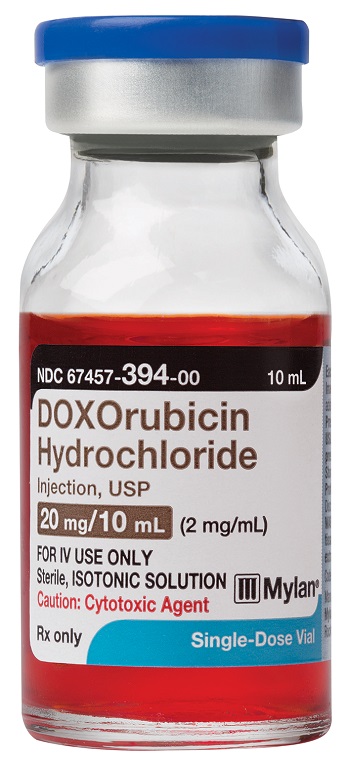
Doxorubicin Hydrochloride for Injection, USP, is a sterile red-orange lyophilized powder.
Doxorubicin Hydrochloride Injection, USP, is a sterile parenteral, isotonic solution.
Indications
Doxorubicin is a potent antitumour agent active against a wide spectrum of malignancies, including leukaemias, sarcomas, breast cancer, small cell lung cancer and ovarian cancer. Doxorubicin is used to produce regression in disseminated neoplastic conditions like acute lymphoblastic leukemia, acute myeloblastic leukemia, Wilms’ tumor, neuroblastoma, soft tissue and bone sarcomas, breast carcinoma, ovarian carcinoma, transitional cell bladder carcinoma, thyroid carcinoma, gastric carcinoma, Hodgkin's disease, malignant lymphoma and bronchogenic carcinoma in which the small cell histologic type is the most responsive compared to other cell types. Doxorubicin is also indicated for use as a component of adjuvant therapy in women with evidence of axillary lymph node involvement following resection of primary breast cancer. Doxorubicin does not playa crucial role in the treatment of tumours that can be cured with chemotherapy, such as testicular carcinoma, nephroblastoma, Burkitt's tumour and choriocarcinoma[3]. Like most other cytostatic agents, doxorubicin is not effective in the most frequently occurring malignancies such as colorectal cancer and non-small cell lung cancer.
Mechanism of action
Doxorubicin has antimitotic and cytotoxic activity through a number of proposed mechanisms of action, however, remaining not fully understood: Data pointing to the role of free radicals, and to damage of mitochondria and membranes, have modified the original hypothesis that DNA-intercalation was the sole cytotoxic mechanism. Meanwhile, the focus on plasma pharmacokinetics has been shifted towards pharmacodynamic studies, with emphasis on cellular doxorubicin concentrations in haematopoietic tissues[4], in solid tumours[5], and in cell constituents. Doxorubicin forms complexes with DNA by intercalation between base pairs. In addition, doxorubicin-iron complexes bind tightly to DNA[6]. However, contrary to intercalated doxorubicin, the doxorubicin-iron complex preserves its ability to catalyze the formation of oxygen free radicals in the presence of double-stranded DNA[6]. Thus, the doxorubicin-iron complex-driven hydroxyl radical formation can proceed in close proximity to DNA and has therefore the potential to damage DNA efficiently, especially since DNA seems to catalyze hydroxyl radical formation by this complex[7]. Hydroxyl radicals are probably involved in damaging of DNA since the generation of hydroxyl radicals by the Dox-iron complex correlates with its ability to cleave DNA[7] and also since catalase, iron chelates and hydroxyl radical scavengers are protective in this system[6]. Relatively high concentrations of hydroxyl radical scavengers were required for protection, indicating that these radicals were indeed generated in a site-specific way.
Moreover, it inhibits topoisomerase II activity by stabilizing the DNA-topoisomerase II complex, preventing the religation portion of the ligation-religation reaction that topoisomerase II catalyzes. Topoisomerase II causes transient double-strand breaks during the twisting of 2 double-stranded DNA helices. Singleand double-stranded DNA breaks have been documented after in vivo and in vitro treatment with doxorubicin of P388 leukaemia cells in mice[8].
Special reference must be made to observations that interference with the cell membrane alone may lead to cell death [9]. Doxorubicin binding to membranes, and particularly its covalent binding to cardiolipin, a phospholipid with 2 negatively charged phosphate head groups, has received much attention[10]. Cardiolipin is found in the inner leaflet of the mitochondrial membrane and is closely associated with electron transport mechanisms. Goormaghtigh et al. (1983) [10] have shown that doxorubicin bound to cardiolipin undergoes redox cycling, producing covalent binding of doxorubicin to cardiolipin in mitochondrial membranes. The hydrophobic nature of the chromophore of anthracyclines allows partitioning into the lipid phase, resulting in changed fluidity of the membrane. Diminished membrane fluidity is related to doxorubicin resistance. A detailed study of the mechanisms involved in doxorubicin-induced changes in membrane structure and function has not been undertaken. However, doxorubicin binds to the epidermal growth factor receptor at clinically relevant drug concentrations, and alters its function.
Administration and formulation
Doxorubicin is available as a dry powder; reconstituted in water, it is most stable at a mildly acidic pH of 4, and unstable at a very acidic or basic pH[11]. When diluted in 0.9% sodium chloride or dextrose 5%, less than 5% decomposition occurred over 7 to 30 days[12]. It is stable in light at room temperature for at least 24 hours [12], although stability may be shorter in plasma and culture media[11].
Doxorubicin has been administered intravenously, intra-arterially, intraperitoneally, intrapleurally and intravesically. A bioavailability of 5% prohibits oral administration[13]. Subcutaneous, intramuscular and intrathecal application cannot be used, as severe tissue necrosis results, as in extravasation.
Pharmacokinetics
Absorption
An intravenous bolus injection of doxorubicin produces high plasma concentrations, which fall quickly due to rapid and extensive distribution into tissues. 50 to 85% of plasma doxorubicin is bound to protein[13], independent of the absolute drug concentration in plasma, leaving 15 to 50% of the total doxorubicin and doxorubicinol as free drug. After repeated injections no accumulation in plasma occurs. Apparent volumes of distribution are in the range of 20 to 30 L/kg (1400 to 3000L)[14].
Doxorubicin does not cross the blood-brain barrier and is therefore inactive against tumours in the central nervous system[15]. Some transplacental passage has been observed, although healthy children have been born after pregnancies during which doxorubicin was administered from the first to the third trimester[16]. Negligible doxorubicin concentrations have been found in breast milk. Salivary doxorubicin concentrations are 6 to 26% of plasma concentrations during the first 75 minutes after administration[17].
Metabolism
Doxorubicin is rapidly metabolized into the hydrophilic 13-hydoxy1 metabolite, doxorubicinol, and the poorly water-soluble aglycones, doxorubicinone and 7-deoxydoxorubicinone. Like doxorubicin, doxorubicinol is cytotoxic, but doxorubicinone is not[18]. Metabolism to doxorubicino1 occurs by cytoplasmatic NADPH-dependent aldoketoreductases, present in all cells, but particularly in red cells, and liver and kidney cells[18]. The non-cytotoxic aglycones are formed by an NADPH-dependent, cytochrome reductase-mediated cleavage of the amino sugar moiety in microsomes. This enzymatic reduction of doxorubicin is of paramount importance, as it finally produces the OH•-radicals, which cause extensive cell damage and cell death[19].
Elimination
Doxorubicin and its catabolites are primarily excreted in the bile[20]. Over 50% is eliminated during the first transit through the liver. Cumulative faecal excretion over 7 days has been estimated at 25 to 45%[21]; no evidence for enterohepatic recirculation has been observed. Although patients often notice a reddish coloration of the urine during the first hours to days after doxorubicin administration, only 0.7 to 23% (on average, approximately 5%) of a dose has been recovered in the urine[20, 21], of which approximately two-thirds is unaltered drug. Nevertheless, doxorubicin-induced nephrotoxicity has been noted only in mice, rats, rabbits and dogs, and not in humans. The reason for this interspecies difference has not been explained, although stimulated lipid peroxidation may play a role[22]. The doxorubicin plasma concentration-time curve can be best described by a biexponentia1 model, which is characterized by a distribution half-life of less than 5 to 10 minutes, and a terminal phase elimination half-life of 30 ± 8 hours[14]. A triphasic curve with half-lives of 12 ± 8 minutes, 3.3 ± 2.2 hours and 30 ± 14 hours has also been proposed[23].
Side effects
Doxorubicin is a carcinogenic and mutagenic substance. Phlebitis is frequently observed after long-term intravenous infusion[24]. Paravasal leakage causes severe necrosis of skin and adjacent tissues, the extent of which depends on the degree of extravasation[25]. An appropriate antidote is not available. A number of agents injected locally may even worsen the necrosis; however, ice packs and 48 hours' rest may be beneficial[25]. Acute doxorubicin toxicity consists of gastrointestinal complaints and cardiac arrhythmias. Nausea and vomiting occur within 4 to 8 hours of doxorubicin administration and can only be partially controlled by antiemetic drugs. Arrhythmias and electrocardiographic changes are transient. Anaphylactoid and hypersensitivity reactions ('flare') may occur during injection, thus mimicking extravasation, but discontinuation of therapy is not necessary[26]. In long term, infusion the occurrence of acute side effects is almost completely abolished. Repeated administrations of doxorubicin bolus injections, and the resultant high doxorubicin plasma concentrations, have been associated with an increased risk of acute and late-onset cardiotoxicity.
Delayed toxicity consists mainly of myelosuppression, alopecia and cardiomyopathy. At approximately 16 days after a single dose of doxorubicin the white blood cell and platelet counts reach their lowest point. Myelosuppression and alopecia are dose related, but independent of the mode of administration (i.e. peak plasma concentration). The onset of myelosuppression occurs after 7 to 10 days, and recovery at 19 to 24 days after doxorubicin administration. This side effect, although reversible, is dose limiting. Hair loss starts approximately 3 weeks after the first administration of doxorubicin; however, hair growth resumes a few weeks after the last therapy[26]. Local application of ice-packs to prevent hair loss have been of limited value. Mucositis and/or diarrhoea are noticed especially during long-term infusion regimens[24].
Overdosage
Acute overdosage with doxorubicin enhances the toxic effect of mucositis, leukopenia, and thrombocytopenia. Treatment of acute overdosage consists of treatment of the severely myelosuppressed patient with hospitalization, antimicrobials, platelet transfusions, and symptomatic treatment of mucositis. Use of hemopoietic growth factor (G-CSF, GM-CSF) may be considered. The 150 mg doxorubicin hydrochloride for injection and the 75 mL and 100 mL (2 mg/mL) doxorubicin hydrochloride injection vials are packaged as multiple dose vials and caution should be exercised to prevent inadvertent overdosage. Cumulative dosage with doxorubicin increases the risk of cardiomyopathy and resultant congestive heart failure (see WARNINGS). Treatment consists of vigorous management of congestive heart failure with digitalis preparations, diuretics, and after-load reducers such as ACE inhibitors.
References
- Arcamone F, et al 1998. Pharmacol Ther 76: 117–124.
- Grein A. 1987. Adv Appl Microbiol 32: 203–214
- Zubrod CG. Historic milestones in curative chemotherapy. Seminars in Oncology 6: 490-505, 1979
- Speth PAJ, et al Clinical Pharmacology and Therapeutics 41: 661-665, 1987
- Cummings J, et al Cancer Chemotherapy and Pharmacology 17: 80-84, 1986
- ELIOT, H., et al (1984) Biochemistry 23: 928-936.
- MUINDI, J. R. F., et al FEBS Lett. 172: 226-230.
- Russo P, et al Anticancer Research 6: 1297-1304, 1986
- Tritton TR, et al Science 217: 248-250, 1982
- Goormaghtigh E, et al Biochemical Pharmacology 32: 889-893, 1983
- Bouma J, et al Pharmaceutisch Weekblad, Scientific Edition 8: 109-133, 1986
- Benvenuto JA, et al Cancer chemotherapy by infusion, pp. 100-113, Precept Press, Chicago, 1987
- Harris PA, et al Cancer Chemotherapy Reports 59: 819-825, 1975
- Greene RF, et al Cancer Research 43: 3417-3421, 1983
- Mooney C, et al European Journal of Cancer and Oinical Oncology 19: 1037-1038, 1983
- Fassas A, et al Nouvelle Revue Fran~ise Hematologique 26: 19-24, 1984
- Celio LA, et al European Journal of Clinical Pharmacology 24: 261-266, 1983
- Bachur NR, et al Journal of Medicinal Chemistry 19: 651-654, 1976
- Myers CE, et al In Lawn (Ed.) Anthracyclines in press, 1988
- Takanashi S, et al Drug Metabolism and Disposition 4: 79-87, 1976
- DiFronzo G, et al Biomedicine 19: 169-171, 1973
- Mimnaugh EG, et al Biochemical Pharmacology 35: 4327-4335, 1986
- Benjamin RS, et al Cancer Research 37: 1416-1420, 1977
- Legha SS, Hortobagyi GN, benjamin RS. Anthracyclines. In Lokich JJ (Ed) Cancer chemotherapy by infusion, pp. 100-113, Precept Press, Chicago, 1987
- Rudolph R, Journal of Clinical Oncology 5: 1116-1126, 1987
- Maral RJ, et al Cancer Treatment Reports 65 (Suppl. 4): 9-18, 1981
Chemical Properties
Doxorubicin is an orange to red cake-like or needle-like crystalline solid. It is a cytotoxic anthracycline antibiotic isolated from cultures of Streptomyces peucetius var. caesius. Doxorubicin hydrochloride is an orange-red, crystalline, hygroscopic powder that is soluble in water and slightly soluble in methanol.
Originator
Adriblastina,Farmitalia,Italy,1971
Uses
Doxorubicin is an anthracycline antitumor antibiotic that inhibits DNA topoisomerase II by inducing double-stranded DNA breaks. By intercalating within DNA, doxorubicin inhibits nucleic acid synthesis and induces apoptosis by inducing the accumulation of the p53 tumor suppressor protein.[Cayman Chemical]
Uses
Strong fluorescent dye intercalating into DNA. Antitumour antibiotic. Effect of adriamycin on heart mitochondrial DNA. Inhibitor of reverse transcriptase and RNA polymerase; immunosuppressive agent.
Uses
Doxorubicin hydrochloride (adriamycin hydrochloride) is an antitumour agent that has been formulated as a salt to achieve higher water solubility. While the salt shares the same pharmacological properties as doxorubicin free base, its greater water solubility may offer advantages in some in vitro applications. Physicochemical properties and chromatographic behaviour will depend on whether the pH is buffered. In non-pH controlled systems the free base and salt may behave differently.
Definition
ChEBI: Doxorubicin hydrochloride is an anthracycline.
Manufacturing Process
Two 300 ml Erlenmeyer flasks, each containing 60 ml of the following culture
medium for the vegetative phase, were prepared: peptone 0.6%; dry yeast
0.3%; hydrated calcium carbonate 0.2%; magnesium sulfate 0.01%; the pH
after sterilization was 7.2. Sterilization has been effected by heating in
autoclave to 120°C for 20 minutes. Each flask was inoculated with a quantity
of mycelium of the mutant F.I.106 (the new strain thus obtained has been
given the code F.I.106 of the Farmitalia microbiological collection and has
been called Streptomycespeucetius var. caesius) corresponding to 1/9 of a
suspension in sterile water of the mycelium of a 10 day old culture grown in a
big test tube on the following medium: saccharose 2%; dry yeast 0.1%;
bipotassium phosphate 0.2%; sodium nitrate 0.2%; magnesium sulfate 0.2%;
agar 2%; tap water up to 100%. The flasks were then incubated at 28°C for
48 hours on a rotary shaker with a stroke of 30 mm at 220 rpm.,
2 ml of a vegetative medium thus grown were used to inoculate 300 ml
Erlenmeyer flasks with 60 ml of the following medium for the productive
phase: glucose 6%; dry yeast 2.5%; sodium chloride 0.2%; bipotassium
phosphate 0.1%; calcium carbonate 0.2%; magnesium sulfate 0.01%; ferrous
sulfate 0.001%; zinc sulfate 0.001%; copper sulfate 0.001%; tap water to
100%. The glucose was previously sterilized separately at 110°C for 20
minutes. The resulting pH was 7. This was sterilized at 120°C for 20 minutes
and incubated at 28°C under the same conditions by stirring, as for the
vegetative media.
The maximum concentration of the antibiotic was reached on the 6th day of
fermentation. The quantity of adriamycin produced at this time corresponds to
a concentration of 15 μg/ml.
brand name
Adriamycin (Pharmacia & Upjohn); Doxil (ALZA); Rubex (Bristol-Myers Squibb).
Therapeutic Function
Cancer chemotherapy
Biological Functions
The C13 substituent of doxorubicin is hydroxymethyl, which retards the action of cytosolic aldoketoreductase and slows the conversion to the equally active, but chronically cardiotoxic, doxorubicinol.
General Description
Adriamycin hydrochloride appears as orange-red thin needles. Aqueous solutions yellow-orange at acid pHs, orange-red at neutral pHs, and violet blue over pH 9. Doxorubicin is available as both the conventional dosageform and a liposomal preparation, both of which are administeredby infusion. Doxorubicin HCl powder is available in10-, 20-, 50-, and 150-mg vials and is widely used in treatingvarious cancers, including leukemias, soft and bone tissuesarcomas, Wilms tumor, neuroblastoma, small cell lungcancer, and ovarian and testicular cancer.
Air & Water Reactions
Water soluble.
Reactivity Profile
Amines, like Doxorubicin hydrochloride, are weak chemical bases. They neutralize acids to form salts plus water. These acid-base reactions are exothermic. Amines may be incompatible with isocyanates, halogenated organics, peroxides, phenols (acidic), epoxides, anhydrides, and acid halides. Flammable gaseous hydrogen is generated by amines in combination with strong reducing agents, such as hydrides.
Fire Hazard
Doxorubicin hydrochloride is probably combustible.
Biological Activity
Antitumor antibiotic agent that inhibits DNA topoisomerase II. DNA intercalator that inhibits nucleic acid synthesis and induces apoptosis.
Biochem/physiol Actions
Naturally fluorescent anthracycline antibiotic, anticancer drug. Doxorubicin is a substrate of MRP1 which was first cloned from a DOX-resistant lung cancer cell line. Fluorescent property has been exploited for the measurement of drug efflux pump activities as well as resolving the important question of intracellular localization of various multidrug resistance proteins and the role of subcellular organelles (Golgi and lysosome) in the sequestration of drugs and its implication in drug resistant phenotypes.
Mechanism of action
Liposomes are taken up selectively into tumor cells, presumably because of their persistence in the bloodstream and enhanced permeability of tumor vascular membranes. In liposomal form, the drug is protected against enzymes that generate cardiotoxic free radicals, although this form of the drug can still induce potentially fatal congestive heart failure. Clinical experience with the liposomal formulation is limited, and few studies comparing the long-term toxicity with that of conventional doxorubicin therapy have been conducted. Therefore, all precautions outlined for the use of doxorubin also are employed when the liposomal formulation is used.
Clinical Use
Doxorubicin is utilized either alone or in combination therapy to treat a wide range of neoplastic disorders, including hematologic cancers and solid tumors in breast, ovary, stomach, bladder, and thyroid gland. A liposomal formulation of doxorubicin is used in the treatment of AIDS-related Kaposi's sarcoma and organoplatinum-resistant ovarian cancer.
Potential Exposure
An antibiotic product from streptomyces, used as anticancer drug
Veterinary Drugs and Treatments
Doxorubicin is perhaps the most widely used antineoplastic agent at present in small animal medicine. It may be useful in the treatment of a variety of lymphomas, carcinomas, leukemias, and sarcomas in both the dog and cat, either alone or in combination protocols. Refer to the Dosage references or the Protocols found in the appendix for more information.
Drug interactions
Potentially hazardous interactions with other drugs
Antipsychotics: avoid with clozapine, increased risk
of agranulocytosis.
Ciclosporin: increased risk of neurotoxicity
Cytotoxics: possible increased risk of cardiotoxicity
with trastuzumab - avoid for 28 weeks after
stopping trastuzumab.
Avoid with live vaccines.
Metabolism
This contributes to the longer duration of action compared to analogues that have CH3 at this position (e.g., daunorubicin). Doxorubicin is highly lipophilic and concentrates in the liver, lymph nodes, muscle, bone marrow, fat, and skin. Elimination is triphasic, and the drug has a terminal half-life of 30 to 40 hours. The majority of an administered dose is excreted in the feces.
storage
Room temperature
Shipping
UN2811 Toxic solids, organic, n.o.s., Hazard Class: 6.1; Labels: 6.1-Poisonous materials, Technical Name Required.
Incompatibilities
Incompatible with oxidizers (chlorates, nitrates, peroxides, permanganates, perchlorates, chlorine, bromine, fluorine, etc.); contact may cause fires or explosions. Keep away from alkaline materials, strong bases, strong acids, oxoacids, epoxides
Waste Disposal
It is inappropriate and possibly dangerous to the environment to dispose of expired or waste pharmaceuticals by flushing them down the toilet or discarding them to the trash. Household quantities of expired or waste pharmaceuticals may be mixed with wet cat litter or coffee grounds, double-bagged in plastic, discard in trash. Larger quantities shall carefully take into consideration applicable DEA, EPA, and FDA regulations. If possible return the pharmaceutical to the manufacturer for proper disposal being careful to properly label and securely package the material. Alternatively, the waste pharmaceutical shall be labeled, securely packaged and transported by a state licensed medical waste contractor to dispose by burial in a licensed hazardous or toxic waste landfill or incinerator.
References
1) Zeman et al. (1998), Characterization of covalent adriamycin-DNA adducts; Proc. Natl. Acad. Sci., 95 11561 2) Katoh et al. (1998), Vascular endothelial growth factor inhibits apoptotic death in hematopoietic cells after exposure to chemotherapeutic drugs by inducing MCL1 acting as an antiapoptotic factor; Cancer Res., 58 5565 3) Perez et al. (2011), Anti-MDR-1 siRNA restores chemosensitivity in chemoresistant breast carcinoma and osteosarcoma cell lines; Anticancer Res., 31 2813
Doxorubicin hydrochloride Preparation Products And Raw materials
| Supplier | Tel | Country | ProdList | Advantage | |
|---|---|---|---|---|---|
| Beijing Mesochem Technology Co.,Ltd | +8613651027935 | rachel@mesochem.com | China | 191 | 58 |
| Dideu Industries Group Limited | +86-29-89586680 +86-15129568250 | 1026@dideu.com | China | 29271 | 58 |
| Hebei Mojin Biotechnology Co., Ltd | +8613288715578 | sales@hbmojin.com | China | 12456 | 58 |
| Hebei Lingding Biotechnology Co., Ltd. | +86-18031140164 +86-19933155420 | erin@hbldbiotech.com | China | 878 | 58 |
| Sinoway Industrial co., ltd. | 0592-5800732; +8613806035118 | xie@china-sinoway.com | China | 992 | 58 |
| Henan Tengmao Chemical Technology Co. LTD | +8615238638457 | salesvip2@hntmhg.com | China | 415 | 58 |
| Henan Bao Enluo International TradeCo.,LTD | +86-17331933971 +86-17331933971 | deasea125996@gmail.com | China | 2503 | 58 |
| Anhui Ruihan Technology Co., Ltd | +8617756083858 | daisy@anhuiruihan.com | China | 994 | 58 |
| Henan Fengda Chemical Co., Ltd | +86-371-86557731 +86-13613820652 | info@fdachem.com | China | 7786 | 58 |
| Hunan aslsen technology co.,ltd | +86-17397237530 +86-19313031929 | aslsd@aslsen.com | China | 128 | 58 |
Related articles
- Adverse reactions of doxorubicin hydrochloride
- Doxorubicin hydrochloride is an anti-tumor antibiotic.
- Mar 30,2022
- What is Doxorubicin hydrochloride?
- Doxorubicin hydrochloride is an antitumor antibiotic agent that inhibits DNA topoisomerase II. DNA intercalator that inhibits ....
- Sep 2,2021
View Lastest Price from Doxorubicin hydrochloride manufacturers
| Image | Update time | Product | Price | Min. Order | Purity | Supply Ability | Manufacturer | |
|---|---|---|---|---|---|---|---|---|
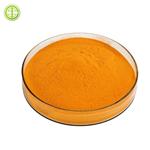 |
2024-04-22 | Doxorubicin Hydrochloride
25316-40-9
|
US $0.00-0.00 / Kg/Bag | 1Kg/Bag | 99% up, High Density | 20 tons | Sinoway Industrial co., ltd. | |
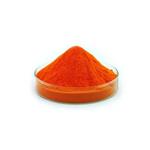 |
2024-04-22 | Doxorubicin hydrochloride
25316-40-9
|
US $10.00 / kg | 1kg | 99% | 10000 tons | Hunan aslsen technology co.,ltd | |
 |
2024-03-16 | Doxorubicin hydrochloride
25316-40-9
|
US $0.00 / KG | 100g | 98%+ | 100kg | WUHAN CIRCLE POWDER TECHNOLOGY CO.,LTD |
-

- Doxorubicin Hydrochloride
25316-40-9
- US $0.00-0.00 / Kg/Bag
- 99% up, High Density
- Sinoway Industrial co., ltd.
-

- Doxorubicin hydrochloride
25316-40-9
- US $10.00 / kg
- 99%
- Hunan aslsen technology co.,ltd
-

- Doxorubicin hydrochloride
25316-40-9
- US $0.00 / KG
- 98%+
- WUHAN CIRCLE POWDER TECHNOLOGY CO.,LTD
25316-40-9(Doxorubicin hydrochloride)Related Search:
1of4





